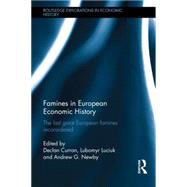- ISBN: 9780415656818 | 0415656818
- Cover: Hardcover
- Copyright: 5/1/2015
This volume re-evaluates economic and geographical aspects of famine in European history, though a comparative study of the Irish Famine 1845-1848, the Finnish Famine (1868) and the Ukraine Famine (Holodmor) of 1932-33. In each case, the book explores: An empirical overview of the pre-and post-famine economic, social, and demographic factors at a national scale. A spatial analysis of regional disparities (e.g. urban/rural) in how the famine catastrophe unfolded in each country and the subsequent long run development of the famine-struck regions, in terms of population dynamics, literacy and education, and economic development. A political geography discussion of how the peripheral location and/or peripheral political status of each country played a role in shaping the government's response, as well as its role in exacerbating the immediate famine and its aftermath. This contributed volume posits that the peripheral political and geographical status of a nation can manifest itself in both exacerbating the immediate famine shock and shaping a given nation's post-famine development. The volume advocates that the impact and long term consequences of famine for a nation should be understood not in isolation, but in the context a nation's relations with neighbouring states. Furthermore, regional structures within a given nation can lead to an unevenness in both the severity of the immediate famine crisis and the post-famine recovery.






